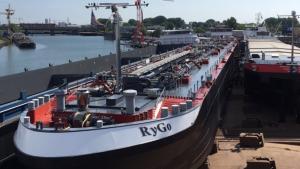Frank Rycquart is an entrepreneur in the inland shipping industry and collaborates within a larger company (AMS based in Zwijndrecht) that focuses on several entities, including tanker shipping and dry bulk. “We focus on industrial transportation. It is no longer a family business but a conglomerate of several companies working together on various aspects in a partially cooperative form.”
Rycquart has been appointed as technical supervisor within the group and is taking part in the CLINSH project for MTS RyGo, a 4000-tonne tanker. “I have already gained good experience with aftertreatment technology in previous projects. We therefore considered it a good idea to take part in CLINSH with a ship like RyGo.”
What makes MTS RyGo so suitable? “The new standards for CCR2 engines have been in force since 2007. Essentially, these engines emit fewer soot particles due to a higher temperature in the combustion chambers. This increase is achieved by injecting more fuel. In other words, CCR2 engines are cleaner but do consume more fuel. If you install aftertreatment systems in older engines, you can save 10% of extra fuel consumption. This is why it is attractive to install aftertreatment systems in CCR1 engines, especially as they have often not even reached half of their life cycle.”
Stalemate in the inland shipping industry
According to Rycquart, a second reason for investing in an aftertreatment system is the ‘stalemate’ in the development of the inland shipping industry. “The industry is hardly developing any new engines within the Euro 6 standard as only around 1000 engines are sold per year in our sector (this is an estimate, ed.). Engineers are unable to pursue any developments with these quantities, as they do, for example, in the truck transport industry.”
Unfortunately, the development costs are too great in relation to the number of engines that will be purchased in the future. “If, for example, you had 1000 marine engines divided over ten different brands, then each brand would only sell 100 engines a year. Companies are not willing to bear the costs of development for this quantity. At the moment, aftertreatment is by far the most efficient technology for cleaner shipping,” Rycquart explains.
Side note
Rycquart believes that part of the success of the CLINSH project is the fact that part of the investment is subsidized. However, he wishes to add a side note to that: “The RyGo was built under our own management at the time, which means that we are reasonably aware of the cost and material prices. I find it frustrating that producers are selling technologies at extremely high prices compared to the type of materials and components that are actually incorporated within them. If such systems were to be sold at realistic prices, then many more entrepreneurs would be inclined to invest in them.”
As soon as you start talking about the environment or the greening process, you can see dollar signs in the eyes of the producers, Rycquart explains. “When you buy a new diesel car, it already contains the catalytic converters. In the shipping industry, you are charged the price of a second engine to have a catalytic converter installed. Producers are asking a disproportionately large amount for these systems and this is partly due to the subsidies. It is a free market so they can charge what they want, but if you analyse the prices, the relationship between the material costs and the so-called ‘engineering’ costs is shocking.”
It sounds like a vicious circle. “Exactly! In terms of my goals, needless to say the environment is a top priority. We all have a responsibility in this regard, certainly as an entrepreneur, but really you are boycotted by the systems that have been artificially brought into the world. Who triggers what first? Unfortunately, green ideas always revolve around money, often large sums of money. This slows down the ultimate objectives.”
Certification
Rycquart believes that certification is an important next step. “I have a ship that has been running with an aftertreatment system for three or four years and a lot of measurements have already been taken. However, no one can issue me with a certification for this as the measurement systems have not been calibrated and government approved. This means that it is not possible to take measurements at the pipe with standards that have been legalized by the state.”
By way of example, Rycquart mentions the alcohol tests that are carried out on public roads. These devices have been calibrated and approved, which means that the devices are identical (acknowledged and legalized by the state), whether you are tested in Rotterdam, Maastricht or anywhere else. Similar equipment for measuring emissions in the shipping industry does not yet exist. “Rotterdam does offer a small discount on port fees if you have an aftertreatment system, but on what grounds is this permitted by law?”
Solution
What would be the best step to break this vicious circle? “It should firstly be made possible for entrepreneurs who have invested in aftertreatment to obtain certification. The government could then, for example, reward shippers with an environmentally-friendly fleet which would encourage them to use cleaner ships for their cargo. This would lead to faster progress.”
An example of a reward could be a tax compensation. This would eventually enable carriers to charge the costs of investment in the freight charge, Rycquart explains. “As soon as cleaner ships become more popular due to this compensation scheme, other skippers will also start thinking about the future. This will lead to far more parties installing an aftertreatment system, which will result in producers being able to offer their technology more cheaply.”
The future of inland shipping
Rycquart thinks that small entrepreneurs will encounter problems in the future. “Sole proprietorships will find it difficult to sustain their business and will seek greater consolidation.” This will lead to larger industrial exploitation groups. In addition, Rycquart believes that we are still in a transition phase lasting around 15-25 years. “As far as I’m concerned, hydrogen is the future, but it’s not that simple. A lot of pioneering work is needed to be able to use hydrogen on an industrial scale in the inland shipping industry.”
“It all may sound quite negative but I only want to point out some fundamental issues. We need to put a positive spin on these issues, for the sake of the objectives and overall importance. It is really important that there are entrepreneurs willing to cooperate on innovation so that other entrepreneurs are subsequently encouraged to take the step. Otherwise you will never know whether something works in practice.”

